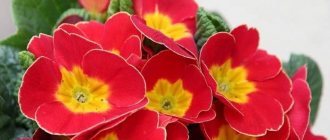Bulbs are the first to greet the beginning of spring. They bloom already in April, when perennials are just awakening from winter hibernation. Therefore, in every flower garden there is at least a couple of bulbous primroses, enlivening the dull landscape of flower beds and giving a spring mood. Of course, you want maximum brightness and abundant flowering for a long time, but this depends on the correct selection of varieties. Some bulbous perennials have a very short flowering phase and disappear quickly. Others cannot stand the excess of May rains; large inflorescences get wet and break, so they also don’t achieve any special aesthetics. Therefore, when purchasing bulbs, you need to pay attention to the flowering period of the variety, resistance to weather conditions prevailing in your area, and ease of care.
- 2 Best bulbous flowers for the garden based on ease of care
- 3 Plants that require special living conditions
- 4 Solo flowers: who is good at single plantings?
- 5 Decorative onions (alliums): beautiful in group plantings
- 6 Spectacular and unpretentious new items
6.1 Glamini: an alternative to regular gladioli
- 6.2 Montbrecia: gladiolus from Japan
Flowering period: the longer the better
Since bulbous plants are grown solely for the beauty of their inflorescences, I want to extend this phase longer. And this is possible if the plants are planted correctly. Many varieties accelerate the flowering period if they grow in the sunny side and, conversely, slow down the wilting process when they are in the shade. Tulips, crocuses, gladioli and lilies exhibit such properties especially strongly. Therefore, they should not be planted in areas where it is sunny all day. It is better that in the first half of the day (when the sun is especially hot) these plants are in partial shade.
In addition, different plants differ in the duration of flowering. For example, the variegated tigridia produces one inflorescence from each bulb in the summer, which lives only 8 hours, after which it immediately withers. So summer residents who come to the site only on weekends may not see this happy moment at all. True, if you plant a group of tigridias, they will not all bloom at once, but this does not change the overall picture much.
Tigridia looks great in group plantings, but each flower lives only 8 hours, after which it immediately fades
The flower shoots of the bird's eye grow gradually, making their way among the thin long leaves, so the plant pleases with beautiful flowers for about a month
The most “long-lasting” spring bulbous flowers include:
- anemone (blooms for about 3 weeks);
- royal hazel grouse (2-3 weeks of flowering);
- tulip (keeps flowers for up to 3 weeks depending on location);
- daffodil (blooms for more than 10 days).
Summer “long-livers” in terms of flowering are considered to be poultry plants, freesia, and some varieties of lilies.
When planting freesias, be prepared that they will require careful care:
How to choose planting material when purchasing?
A lot depends on the choice of bulbs (or corms). Will your flowers grow, will the flowering be lush, will the plants be resistant to adverse conditions, etc.
Therefore, the choice of planting material must be carefully considered.
There are 4 basic rules for choosing planting material when purchasing bulbous plants:
- We look at the size of the corms. It’s better, of course, to take big ones. In the first season they will bloom more luxuriantly.
IMPORTANT! Remember that there are small-bulbed plants (for example, muscari and snowdrop), whose bulbs are small by themselves, and not because they are low-quality planting material.
- We carry out an external inspection of the planting material. The bulbs should be firm and “fresh” to the touch, with no signs of rot or soft spots. In addition, they should not emit a musty odor.
- We examine the bottom. It should also be dry, without rotten areas. Press lightly on the bottom with your finger. It should not be dented or pressed at all.
- Buy Fitosporin or any other fungicide immediately. Planting material is not always treated against diseases, so it is better to take care of this issue yourself.
REFERENCE. There is no need to purchase planting material for future use. Take the bulbs just before planting the flowers.
The best bulbous flowers for the garden based on ease of care
The second criterion for choosing bulbous plants, which is used by “lazy” summer residents, is the degree of care for the plants. The less hassle you have to deal with them, the more profitable it is to grow them.
Many bulbous plants require annual digging after the above-ground parts die off. If this is not done, then the bulbs will become smaller until they disappear or even freeze out in the winter. Such demanding “beauties” include varietal tulips (especially unusual colors, parrot and lily), gladioli, freesia, and hyacinths. So if you don’t want to dig them up, dry them and create conditions for storage, you’ll have to make do with less demanding varieties.
Hyacinth can also be grown in a pot, read about it:
The unusual beauty of parrot varieties of tulips requires special conditions for their growth: annual digging, proper storage and several feedings
Thus, lilies, daffodils, crocuses, all types of decorative onions, anemones, crocosmias, royal hazel grouse, and muscari successfully grow in one place for 3-4 years.
Muscari, or mouse pea, is very unpretentious, grows in one place for several years and quickly reproduces by dividing bulbs and seeds
Plants that require special living conditions
In pursuit of growing large inflorescences, breeders do not always take into account the degree of stem thickness. And many new bulb varieties have huge flowers but thin stems. This, of course, looks gorgeous in a flowerbed when the weather is warm and calm. But if during the flowering season there is a rainy season or a strong wind rises, all the beauty will instantly fall to the ground, because the thin stem will not withstand the swinging or the wet, heavy inflorescence. This situation can occur with many varieties of double daffodils and freesias.
Recent Entries
Lilac perennials that are beautiful, compact and do not crowd out other plants Why when buying seedlings you should not take the sellers’ word for it and how to determine the age of the plant using 3 signs Tomato seedlings have turned purple or whitish: why the color has changed and how to save the plants
The more petals in the inflorescence of a double narcissus, the faster it gets wet and puts its weight on the thin flower arrow
Gladioli often break, but not because the stem is weak. On the contrary, a powerful flower arrow with an abundance of large inflorescences becomes a heavy burden for the bulb. And it is at the point where the stem begins to grow that breaking occurs during windy weather. Therefore, many plants with tall stems will have to be tied up as soon as flower stalks begin to appear. You can, of course, immediately plant bulbous plants near a net or fence, but such a place is not available in every area. By the way, a very close “relative” of the gladiolus – acidanthera – is absolutely not afraid of the winds. However, only one flower produces.
Solo flowers: who is good at single plantings?
When decorating flower beds, bulbous plants can act both as soloists, thanks to their high growth and large inflorescences, and as a background. Gladioli, some varieties of lilies, acidanthera, and crocosmia are considered the tallest. But if the lily is good in a single planting, then it is better to plant the rest in a small group, because their peduncle is narrow and bare before the inflorescences begin.
Not every flower in the garden can compete with the beauty of lilies and their high growth, which is why they are given the best places in flower beds
Royal hazel grouse look good in the center of flower beds. True, choosing a background for them is quite difficult. These bulbs are among the first to bloom. But among conifers, creeping perennials, climbing plants and decorative onions, they look truly royal. And if you plant it in a group with a lily, then while it gains strength and growth, the hazel grouse will have time to bloom and generally disappear, giving way to its followers.
Article on the topic: Planting bulbous flowers in autumn: general rules + review of the best 6 varieties
Popular types
Bulbous indoor and garden flowers can be of various types. You've probably heard many of the names mentioned in the article. All plants shown in the photo are found in the regions of our country:
Lily of the Valley (CONVALLARIA)
Everyone has seen elegant white bells with an amazing aroma. In order for lily of the valley to delight you with flowering during the Christmas holidays, it is recommended to purchase its rhizomes and plant them in mid-November.
Photo gallery
Chionodoxa
There are several popular types:
- Sardskaya - blue flowers
- Giant - flowers up to 4 cm in diameter, planting occurs in September
- Lucilias are blue, star-shaped flowers with a white center. They bloom in late winter.
Vesennik (ERANTIS)
Spring Tubergen has flowers with a diameter of 5 cm. Winter has yellow flowers with a “collar” of leaves.
Galtonia
The plant has an impressive size. The bulbs are planted in the fall, and in the summer, bells form on the peduncles - 20 or more.
Saffron (CROCUS)
In everyday life, other names for flowers of this type are often used, for example, crocus. Planted in the fall to produce plants in the spring.
As a rule, the color of the petals is yellow, but pink and pale blue shades can also be found. Flowering occurs from January to February. The most popular varieties are Pickwick (lilac with purple stripes), Vanguard (silver-pink).
Decorative onions (alliums): beautiful in group plantings
A large group of bulbous plants for the garden are decorative onions. Over 150 varieties of them have been selected, but for some reason alliums are used much less often than tulips or gladioli in the design of flower beds. But in vain! These plants have very compact tubular leaves that form a bush, and the number of flowers on one plant reaches 60 pieces. Decorative onions have a long growing season, so they will be beautiful all spring and summer, even if the flowering period has not yet arrived. Varieties differ in flowering time. Early onions begin to bloom by mid-May, and late ones - at the end of August, and the flowering duration is a month or more.
These bulbs are good for decorating the edge of the border, the lower tiers in multi-stage flower beds, and including in mixborders. And, for example, the chives variety can also be eaten. In spring, its thin tubes emerge from the ground very early, ahead of even winter onions, so you will get double pleasure - both aesthetic and nutritional.
The chives, whose feathers you did not have time to eat in early spring, will produce beautiful lilac balls-inflorescences by summer, decorating a garden bed or flowerbed.
Methods of propagation of bulbous (corm) plants
Bulbous plants reproduce:
- children (daughter bulbs);
- division (corms);
- tubers;
- seeds.
Propagation by seeds is used mainly in breeding work. Mature mother corms are used for division. Using a sharp, disinfected knife, cut the onion into pieces, each of which has at least one viable bud. The cut areas must be sprinkled with crushed activated carbon, ash or lubricated with brilliant green.
To rejuvenate a plant (for example, gladioli), propagation by tubers is used. You can grow high-quality planting material yourself. In order to get a large number of daughter bulbs in one season, it is necessary to plant the mother corm upside down.
Spectacular and unpretentious new items
The bulbous plants that inhabit most flower beds are known to everyone: tulips, lilies, gladioli, daffodils, snowdrops. But names such as glamini or montbretia are known only to lovers of exotic bulbs. We do not buy new items, fearing the difficulties of care, although there are no special problems with these plants.
Glamini: an alternative to regular gladioli
The term “glamini” refers to miniature gladioli, the height of which does not exceed half a meter. They bloom much earlier and, unlike their giant “brothers,” do not bend or bend from the wind. Such varieties are grown both in open ground and on balconies. The only negative is the annual digging for the winter and storage in the refrigerator.
Glamini has no fewer colors and varieties than ordinary gladioli, and they tolerate windy weather and rain much better
Eucomis
The small flowers of this bulbous plant are collected in a long cylindrical raceme, which is crowned with a green “comb” of leaves.
It is best to grow eucomis in individual pots or large containers of several plants in order to be able to bring the container indoors for the winter. There is no need to dig up the bulb. During the dormant period, the plant, like other bulbous plants, does not need to be watered.
In its homeland, South Africa, eucomis grows on damp mountain slopes, so during the period of active growth and flowering it needs good moisture, as well as regular feeding.
If you live in the south, then you can easily afford to grow eucomis in border plantings, in rock gardens, or in a flower bed.
Among flower growers, the most popular are Eukomis bicolor (green), Eukomis bicolor alba (white), Eukomis komosa, also crested (mixed green and white).
| Bloom | July August |
| Plant height | 30-60 cm |
| Planting depth | 5-6 cm (the bulb should be completely covered with soil) |
| Distance between bulbs | 8-10 cm |
| Underground part | bulb |
| Light requirements | |
| Purpose | |











